Do you want a spotted dog for your next family pup but aren’t sure which one is the right fit? Below you’ll find 22 different spotted dog breeds, with each of them carrying distinctively different pup personalities! Some breeds, like Dalmatians, are well-known spotted pups. Other breeds like the Jack Russell Terrier or the Beagle are known for spots but not quite as iconic.
Coat color is linked to dog genetics. As a result, some breeds are more likely to carry different colored coats with spots. We’ve only listed purebreds, but any dog with a parent of the purebreds below will have a chance to have some spots. Examples include Dalmatian mixes, Beagle mixes, or even Great Dane mixes.
So, think you are ready for your spotted pup to come home from the breeder or shelter? Let’s get to know each breed, their ability to be a family dog, and whether they will line up with your lifestyle.
- American Bulldog
- Australian Cattle Dog
- Australian Shepherd
- Beagle
- Bluetick Coonhound
- Border Collie
- Brittany Spaniel
- Catahoula Leopard Dog
- Chihuahua
- Cocker Spaniel
- Corgi
- Dalmatian
- Dogo Argentino
- English Bulldog
- English Setter
- English Springer Spaniel
- German Shorthaired Pointer
- Great Dane
- Great Pyrenees
- Jack Russell Terrier
- Staffordshire Terrier
- Wirehaired Pointing Griffon
- Final Thoughts
American Bulldog

American Bulldogs are often seen with spots, but usually only when they have a white coat. Spots can range in color, but black is the most common, followed by brown. It’s possible to have a black American Bulldog with white spots, but these are very uncommon. Usually, American Bulldogs have shorter coats, and their grooming requirements are not as needy as other breeds.
American Bulldogs are strong-headed and very strong-willed. They are not recommended for first-time dog owners. These pups are often considered the same breed as a Pitbull, although they aren’t. This is a powerful breed, and not training them properly as puppies can result in behavior problems as they age. They are also destructive if not exercised adequately, so it’s recommended that you at least have a home with a small yard if you plan to adopt one of these pups.
Australian Cattle Dog

Often mistaken for the Aussie, the Australian Cattle dog is a shepherding breed that can have a spotted coat. The Australian Cattle Dog is a notorious shedder, so you’ll need weekly brushing sessions to keep hair out of your home. These pups have a unique salt-and-pepper coat, with tinges of tan mixed throughout. Their spots are black and can sometimes carry smaller white patches on their body. Their coats can also be white and tan, with different spotting combinations as well.
These little pups are extremely active and have energy levels that rival the Border Collie. They were bred for similar purposes and do better with room to roam. This breed can survive in smaller homes or apartments, though, provided they have an adequate 60 minutes of exercise every day.
Australian Shepherd

The Aussie is another cherished breed, with many variations of a spotted coat. These fluffy pups have medium-length coats and are also notorious for shedding. You’ll want to have bi-weekly brushing sessions to keep the hair down to a minimum. Australian Shepherds can have a number of different spotted coats. Usually, you’ll see some mix of brown and white, or merle, which is brown, black, and white.
Aussies are notoriously energetic. If you plan on bringing one home, it’s recommended that you have enough time to spend exercising them daily. We recommend at least 60 minutes of exercise for young Aussies to get tuckered out. Having a yard is good for this breed, but because of their size, apartment life is fine, provided you get them outdoors daily.
The German Shorthaired Pointer has the same activity level as a field Labrador. They are energetic and are slightly smaller than the Labrador Retriever. They were bred for hunting and make steadfast fowl hunting companions. While they can survive in an apartment with adequate exercise, it’s recommended that you have a home with a yard if you intend to welcome a GSP into your family.
Beagle

Beagles are another breed that has plenty of spots. Their spots are usually brown and appear on the white parts of their coat. Some Beagles have “ticking,” a pattern of colored hair that shows up as tiny spots of colored hair inside an area that would otherwise be white. Beagle coats are shorter, and their shedding is on the lower end. Their coats are short and dense and should be groomed weekly to keep shedding to a minimum.
Beagles are one of the most popular family dogs in the United States. Due to their gentle nature, and keen noses, they can serve as both hunting companions and basic family pets. Beagles do well with other dogs and kids. Their size makes them easy to manage, and they can live just fine in smaller living spaces. Beagles need about 30 minutes of exercise each day to keep them out of mischief.
Bluetick Coonhound

Bluetick Coonhounds are spotty-coated hunting dogs that are known for their keen sense of smell. Coonhounds don’t shed as much as some of the other breeds on this list. Their coats are shorter and lower maintenance. Generally, the Bluetick will have a white, black, and tan coat. Most of their spots appear on the white portions of their body in either black or brown coloring.
Bluetick Coonhounds are very energetic. While they can do ok in a smaller living space like an apartment, we do recommend a home with a backyard. These pups are medium to large-sized dogs and can be stubborn when training. We recommend more experienced dog owners look to the Coonhound as their first pet. Bluetick Coonhounds will get along with most household animals if introduced to them early. They do have a tendency to chase due to having a high prey drive.
Border Collie
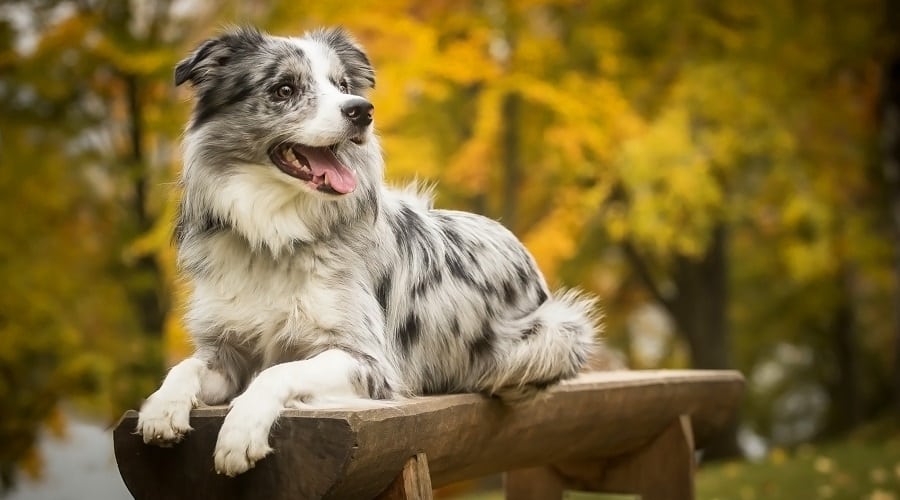
Border Collies are an energetic favorite with a spotted coat. They can have a variety of different coat colors, which will range from white to black and white, tan, and blue merle. Any of their color combinations can have a spotted coat. Border Collies are famous for their long beautiful hair and intelligent nature. They do shed fairly aggressively, so you’ll want to make sure you are up for daily brushing and weekly grooming to keep hair away.
Borde Collies are working dogs. They can do just as well on the farm as they can in an apartment, provided they are exercised regularly. Border Collies need at least 60 minutes of exercise each day. They make the perfect training companion for agility work and just being a good family dog. They are also one of the top breeds that seem to get mixed with other purebreds. Overall, the Border Collie is one of the better breeds for families if you can keep up with their energy levels.
Brittany Spaniel

The Brittany Spaniel is another medium-sized hunting dog with spots. These pups originated in France sometime in the 17th century. Brittany Spaniels have variations of white and brown coats. The brown portion of their coats will show up as spots, with some spots being much larger than others. Their coats are medium length, and they shed frequently during the early summer months when blowing their coat.
Brittany Spaniels have a ton of energy! Because of their hunting genes, they like to be active and will need a minimum of 60 minutes outside each day to ensure they don’t become destructive. The Brittany Spaniel is a very easy dog to train, rivaling other sporting dog breeds.
They are generally friendly with strangers and are eager to please their owners. They also make great family pets. The Brittany Spaniel is commonly confused with their more American breeding line, which is just called the Brittany.
Catahoula Leopard Dog
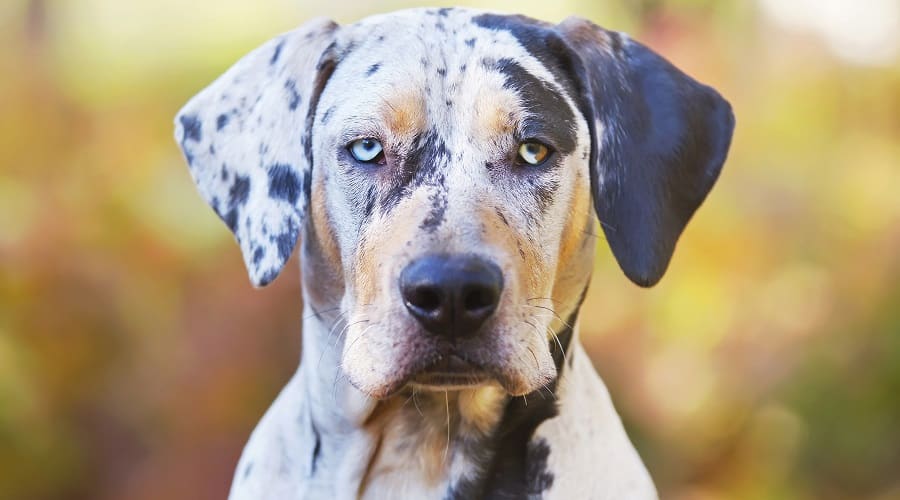
The Catahoula Leopard dog is a spotted breed that has a widely varied coat color. Catahoulas can be white with black spots, grey with black spots, and a whole lot of other colors in between. They also commonly have blue eyes or heterochromia, which are two different colored eyes. Catahoulas also have short coats that are very dense. They shed regularly, so semi-weekly grooming is recommended to keep shedding down. Most often, when people ask what dog breed is spotted like a leopard, they are talking about the Catahoula Leopard dog.
Catahoulas require a strong owner as they can be a dominant breed. They are active and can be used as both watchdogs and guard dogs. Because of their guarding nature, early socialization is key. Because of their energy levels, a larger yard is usually recommended if you intend to bring home a Catahoula.
Chihuahua

Chihuahuas are the smallest spotted breed on our list, with any color of coat having the ability to carry some spots. No matter the color of the Chihuahua’s skin, each coat color has the potential for a Chihuahua to have spots. Their coats are short, and their grooming needs are pretty minimal. Both the Deer Head and Apple Headed Chihuahuas have the ability to have spotted coats. They will need weekly brushing and don’t shed much, even during the shedding season.
Chihuahuas are loud and protective. They make good watchdogs, as they will alert their owners to any potential dangers that may arise. Because Chihuahuas are smaller, they are easier to manage when it comes to training. They can absolutely be stubborn, though, so if you own a Chihuahua, be prepared to train them early. Chihuahuas are one of the more aggressive dog breeds, and not because it’s in their nature. Because they are small, aggressive behavior often goes unchecked. This can become a problem when interacting with other dogs. Despite this, Chihuahuas can make unforgettable family pets, provided they are trained and socialized early in their lives.
Cocker Spaniel
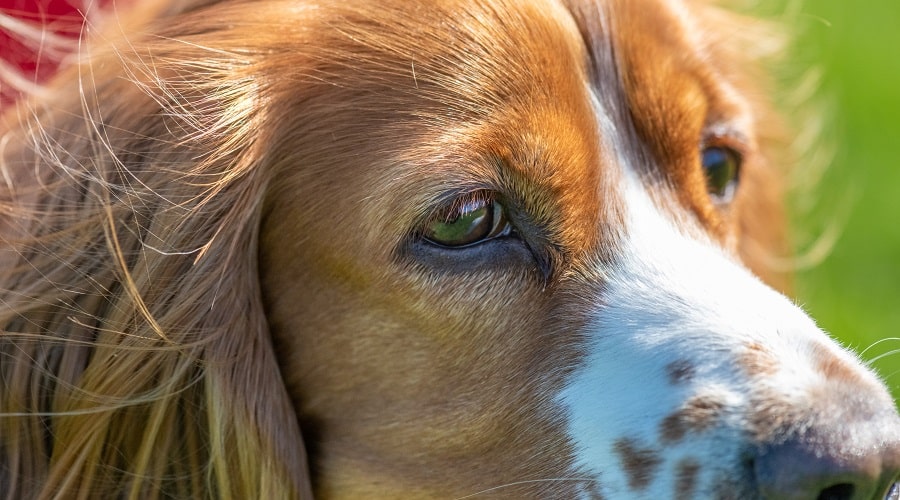
The Cocker Spaniel is a popular spotted pup. While Cocker Spaniels are most widely portrayed as having a golden-colored coat, they actually quite commonly have spots. Cocker Spaniels have longer coats, and the typical spot formations are Cockers with white coats and either golden or black spots.
Cocker Spaniels are great for just about any type of family. They do great with kids and other dogs. They have been known to become slightly territorial if not socialized properly when they are puppies. While they are active as puppies, they are not overly energetic as they move into adulthood. Overall, these spotted pups make excellent family companions.
Corgi

Both Pembroke and Cardigan Welsh Corgis can have spotted coats. These pups have medium-length coats and can come in a variety of different colors. Spots will appear on any of their color combinations and are more popular with the blue merle coat color combination. Corgis need regular grooming and will definitely shed more than other breeds on this list.
Corgis are full of energy when they are younger but tend to cool down when they get older. They are quirky and are famous for their adorable tails. Corgis can survive just fine in an apartment. Even though they are technically a working breed, they typically only need 30 to 45 minutes of daily exercise to curb destructive behavior. They are just as likely to cuddle up in your lap as they are to want to go for a run.
Dalmatian

The Dalmatian is the most famous spotted breed on this list, and the first one most people think of when asked about a spotted dog. This pup is the star of Disney’s 101 Dalmatians and is well known as the firefighter’s mascot. Dalmatians have short white coats with black spots. There is a possibility for Dalmatians to carry a blue-eyed gene, but this usually results in them being deaf. They are not initially born with black spots. They are born with white coats, and their spots develop over the first 3-4 months.
Dalmatians are not recommended for first-time dog owners. They have a stubborn streak, and this can be difficult to manage when you have a dog that weighs up to 80 pounds when they are fully grown. They also have high energy levels, so you’ll likely want a larger yard if you bring one home. If you do not exercise them daily, they can become destructive, which results in poor behavior, anxiety, and other behavioral issues.
Dogo Argentino

Another breed that’s compared to the Pitbull, Dogo Argentinos are usually completely white. But they can bring black spots into their coats from time to time. Dogos have short hair and don’t require much grooming or maintenance at all. They do shed their coats during the early summer season, but weekly brushing is usually sufficient. Dogos will not have any other color combination with regard to spots on their coat.
Dogo Argentinos are very strong-willed dogs. Like the American Bulldog or the Pitbull, the Dogo Argentino is not recommended for first-time dog owners. These pups are large, with some weighing 90 pounds or more. Due to their strong will and guardian instincts, it’s recommended that owners have experience handling stubborn breeds. Once properly trained, the Dogo can make a wonderful family companion or home protector.
English Bulldog

English Bulldogs are one of the oldest spotted dog breeds. These pups have short spotty coats, usually with a white base coat. Spots show up in tan, black, or brindle-colored spots. The English Bulldog has a short coat, and their grooming requirements are pretty minimal. It’s recommended that you brush them weekly, especially during early summer when they shed their winter coats.
The English Bulldog is very stubborn. Because of the way they look, they are often associated with being less intelligent than other breeds. Quite the contrary, though. They might not comply with commands, or it may take multiple training sessions to master a basic obedience lesson, but this is often not because they are less intelligent. They are highly independent breeds and will often not listen, even if they understand their commands. For this reason, English Bulldogs aren’t recommended for first-time dog owners.
English Setter
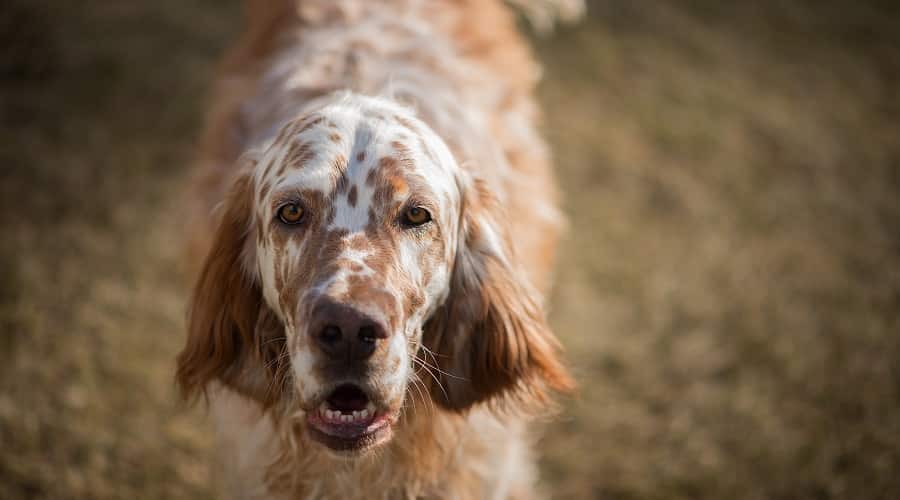
The English Setter is a hunting breed that has been around for centuries. A perfect waterfowl hunting companion, the English Setter also has a spotted medium to longer-length coat. Their coat color can vary, with the most common being a white base and either brown or black spots. These pups shed, and they have long hair. You’ll want to make sure you are brushing your pup daily and grooming them at least a few times per month.
The English Setter is generally easy-going and eager to please their owners. They get along well with other pets. They do have a high prey drive, so training from a young age is essential. The English Setter is a great family dog that does well with Children. Because of their exercise and activity needs, we recommend having a home that has a yard if you intend to welcome an English Setter into your family.
English Springer Spaniel

The English Springer Spaniel is another spotted pup that has a lengthy history. These pups have medium-length curly coats. Common colors include brown & white with brown spots and black & white with black spots. Because their hair is medium length and can get quite long, you’ll want to plan for above-average grooming requirements. These pups will need to be brushed regularly to keep their hair from taking over your home.
Springer Spaniels are highly active dogs. They are a hunting breed, so they are used to being outdoors in their element. English Springer Spaniels were originally founded in England during the 1800s as a breed and have a history as a steadfast hunting companion. They are medium-sized pups that weigh about 40-50 pounds. You’ll likely want a yard or at least have the ability to exercise regularly.
German Shorthaired Pointer

The German Shorthaired Pointer is a spotted dog breed that’s probably as much associated with spots as the Dalmatian. This hunting breed is one of the 10 most popular dogs in the United States. They have very short coats and are not notorious for shedding. GSPs are typically brown or brown with a white coat and dense brown spots. Shedding is minimal compared to other fluffier dog breeds.
Great Dane

Great Danes can carry spots on any color coat. It’s most common on white Great Danes or those with merle-colored coats. Spots can range in color but are generally grey or black against a white coat. Great Danes do shed, but not excessively. They will need regular grooming during their shedding season to keep their excess hair off your couch. Their shorter coats make regular brushing relatively easy, and they do not really need to be de-shed.
The Great Dane is a couch potato and can do well even in an apartment with as little as 30 minutes of daily exercise. They can be more difficult to train, as the breed can be quite stubborn. These gentle giants can get upwards of 130 pounds, so they are not recommended for first-time dog owners that may not have experience with giant breeds. One of the most lovable and famous Great Danes is the cartoon pup Scooby Doo.
Great Pyrenees

The Great Pyrenees, also known as the Pyrenean Mastiff, is a breed that is more well known for having a white coat. They can, however, also have a white coat with black spots. They have long hair and require extensive grooming to keep shedding to a minimum. If you have dark-colored furniture, expect your Pyrenees to leave behind a little piece of themselves pretty much everywhere they go.
The Great Pyrenees is a strong-willed and stubborn breed. Because they descend from the Molosser, they can get quite large. Due to their hard-headedness and their enjoyment of being in the field, it’s not recommended that the Great Pyrenees is a dog for first-time dog owners. You will need to be firm and consistent with training if you decide to bring one home. They do make great family dogs and are gentle with children.
Jack Russell Terrier

The Jack Russell Terrier is a small spotted dog breed. Their coats usually have a white base, with some types of tan spots through the body and on the head. They can have varying sizes of spots and have relatively short coats. While the Jack Russell Terrier sheds more frequently in shedding season, their grooming needs are a little more low-key due to their shorter hair.
The Jack Russell Terrier is one of the smartest dog breeds. They are easily trained but can also be a bit stubborn at times. It’s recommended you start training your JRT early so they learn basic obedience commands. The JRT gets along well with most other dogs as long as they are socialized early. They also love to cuddle and make fantastic family companions.
Staffordshire Terrier

Staffordshire Terriers are one of the four different breeds referred to as Pitbulls. The American Pitbull Terrier would also be considered a spotted dog breed on this list, but since they aren’t an official AKC breed, the Staffordshire Terrier takes their place. Spots can vary in color, but like the English Bulldog, common spotted coat colors are typically white with either tan or black spots. They have short coats, and grooming requirements are less needy than other breeds.
Similar to the Dogo Argentino, the Staffordshire Terrier is stubborn. They are highly trainable and active, though. They enjoy learning new tricks and basic obedience commands. We recommend that you have a decent-sized yard if you own a Staffy or can at least take them for daily walks. This breed is perfect for people who love to walk or need to get out and exercise daily for their own health. Staffordshire Terriers need about 45 minutes of exercise each day and can make wonderful family companions if trained effectively.
Wirehaired Pointing Griffon

A fantastic hunting dog, the Wirehaired Pointing Griffon is known as the Griffon, or “Griff” for short. These canine companions are one of the most popular hunting dog breeds in the canine kingdom. They are an extremely active breed, and some would say that their activity levels rival the Labrador Retriever, especially as puppies.
The Griffon’s coat is short and wiry. Many hunters elect to keep their Griff’s coat on the shorter side since it’s less likely to collect burs, thorns, and thistles when out in the brush. This breed is medium to large in size and will weigh up to 70 pounds, depending on their parents. Their wiry coats are typically white or brown and have some different spotting variations within them. These pups are also excellent family companions if you have the energy to keep up with them.
Final Thoughts
No matter which dog breed you choose, any of the spotted dog breeds above can make a great family pet if properly trained. Spotted dogs come in all shapes and sizes. While there are many Purebred spotted dog breeds, there are also many mixes that carry their parent’s spotted genes.
As always, we recommend you adopt before you shop! Make sure to look at local rescues and shelters before heading out to find your very own speckled friend to add to your family.




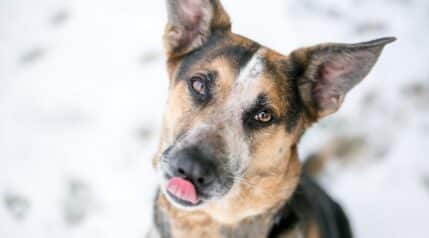
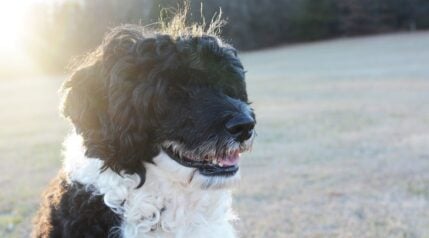

i love dog and puppies!!!!!!!!!!!!!!!!!!!!!!!!!!!!!!
Nice selection, but please include the pointer, as in the english pointer. Beautiful dogs and most have spots, orange, black, lemon or liver.
Hello 😊 love the article. What is the breed of the dog in the very first photo? She or he is just lovely!
❤️
Springer Spaniel
Hello i was really wondering what type of breed my dog is i dont know much about him because someone gave him to me his name is also lucky. he is a white dog with a couple of brown spots on him and has a big brown spot on one of his eyes but i think he could be a mixed dog breed it. but i thinking maybe one of the breeds might be a jack Russel terrier. Lucky is also really hyper and is pretty fast. I still dont know how old he is, but i know he is probably still a baby because he is still teething, and he is starting to git bigger and having more spots. I was just hoping you could help me find out what breeds he i would love to know…kindness regards-thank you.
We recommend that you do an at-home DNA test or your local vet may also be able to provide some guidance.
This dogies r cute
😉
Hello – I was delighted to discover your article. The mystery of our Cooper deepens as he grows older. He is currently 13 weeks. When we rescued him at 9 weeks, everyone thought he was JRT and Yorkie. Now he looks JRT and tri-color sheltie, but I think I see a beagle body.
Frankly, he could represent many dogs. It does not matter one bit about his history. We adore him no matter what. Curious to know more about the DNA testing that you mentioned under comments. You’d like Cooper, he’s the sweetest dog ever and loves everyone…very energetic and super smart.
If you would, please…send the DNA testing info to my email…we’d love to check it out. Kindest regards.
Hi Viola! Sounds like you have a very interesting canine companion! Regarding the DNA testing – if you search for “fluffy mastiff” here on our site, you’ll see some of the results. I plan to do a write up at some point on my experience with Embark. We just got testing back for our most recent rescue dog, and it was spot on!
With Embark – wait for the sales! You can usually get the DNA tests with a solid discount if you are on their mailing list. We did the whole health panel to know if our pups had any genetic predispositions to be aware of. Thanks for commenting, and good luck!
I have a 66-pound dog whose mother is Australian Shephard and Blue Heeler. He is brown spotted with brown ears and an extremely long tail. About 16 inches long. His muzzle has lots of spots and his ears flop like the German short-haired pointer. Any ideas?
Hi Karen! It would be difficult to guess the breed of your pup without seeing a picture. If you want to know the breed, I would definitely encourage you to have a DNA test done. We’ve used Embark twice, and have great results. Good luck!